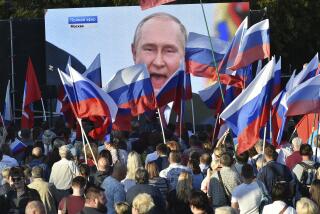SPECIAL REPORT: Seeking a New World : The Year 2010: A View From the State Department
- Share via
With the turn of the millennium approaching and the end of the Cold War remaking the map, governments around the world have sent scholars to their crystal balls. Most of the resulting reports have been unmemorable -- but one provocative forecast has come from the U.S. State Department. Written by Michael Vlahos, director of the department’s Center for the Study of Foreign Affairs, it offers some predictions for the next 20 years:
* A global power balance is dominated by three world powers: the United States/Canada, the European Community and Japan. The main concern for U.S. foreign policy becomes the economic and political challenge posed by the EC and Japan.
* The decomposition of the Soviet Union continues through the 1990s. Most of the non-Slavic republics gain independence, and a new federation dominated by Russia, the Ukraine and Byelorussia emerges around 2010. Its gross national product and production technology will be roughly equivalent to those of India and China.
* The European Community progresses steadily but slowly toward complete economic integration and political confederation. The Eastern European economies will be absorbed and dominated by the Continent’s strongest financial power, the new Germany. The Soviets, too, will rely on German financing to stay afloat. By 2010, most American military forces are withdrawn from the Continent.
* East Asia becomes a cockpit of competition, not integration. A decline in U.S. ability and willingness to maintain large military forces across the Pacific, plus the growing strength of Asian countries’ own armies, will gradually end America’s role as the referee of East Asian affairs. A united Korea emerges as Japan’s most aggressive competitor. Japan’s relations with its neighbors become touchy.
* The United States reassesses its role in the world and its domestic political system. In the wake of the Cold War and amid a widespread perception that the federal government isn’t working, domestic politics turns to the job of renewing the American system. Party realignment follows. The U.S. world role turns somewhat more isolationist, under a doctrine of “selective engagement” that avoids long-term commitments like those of the Cold War.
* The political use of military force declines. Production technology is seen increasingly as the new yardstick of world power, replacing the traditional measures of heavy ground forces and nuclear arsenals. But the world powers do continue to deploy military forces, concentrating their interest on the oceans--and outer space. NATO gradually recedes in importance; Western Europe becomes an autonomous military power.
* Regional conflicts and instability continue. The United States, Japan and the Western Europeans attempt to maintain world stability through joint action, but the United States finds itself increasingly at odds with the others as the stakes in the global economic competition grow. Major regional issues may escalate as the world powers assist different sides. Potential clashes among China, India and the Soviet Union could threaten other powers’ interests.
Are President Bush’s advisers using this as a blueprint? “I don’t think so,” Vlahos laughs. “They haven’t had time to read it. They’ve been completely caught up in the events of the moment.” On the other hand, the Soviet Embassy in Washington took four copies.
More to Read
Sign up for Essential California
The most important California stories and recommendations in your inbox every morning.
You may occasionally receive promotional content from the Los Angeles Times.













